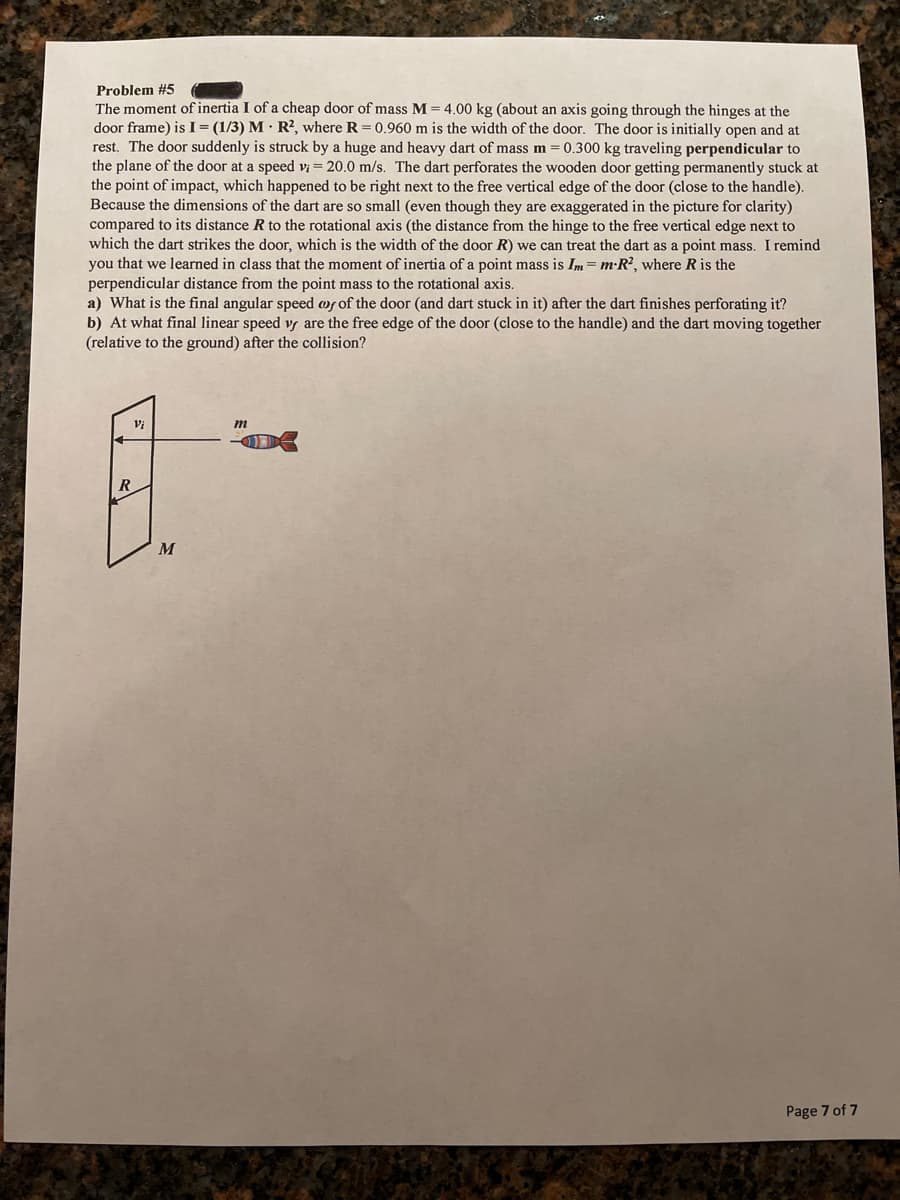Problem #5 The moment of inertia I of a cheap door of mass M=4.00 kg (about an axis going through the hinges at the door frame) is I= (1/3) M · R², where R= 0.960 m is the width of the door. The door is initially open and at rest. The door suddenly is struck by a huge and heavy dart of mass m= 0.300 kg traveling perpendicular to the plane of the door at a speed v = 20.0 m/s. The dart perforates the wooden door getting permanently stuck at the point of impact, which happened to be right next to the free vertical edge of the door (close to the handle). Because the dimensions of the dart are so small (even though they are exaggerated in the picture for clarity) compared to its distance R to the rotational axis (the distance from the hinge to the free vertical edge next to which the dart strikes the door, which is the width of the door R) we can treat the dart as a point masS I remind %3D %3D
Problem #5 The moment of inertia I of a cheap door of mass M=4.00 kg (about an axis going through the hinges at the door frame) is I= (1/3) M · R², where R= 0.960 m is the width of the door. The door is initially open and at rest. The door suddenly is struck by a huge and heavy dart of mass m= 0.300 kg traveling perpendicular to the plane of the door at a speed v = 20.0 m/s. The dart perforates the wooden door getting permanently stuck at the point of impact, which happened to be right next to the free vertical edge of the door (close to the handle). Because the dimensions of the dart are so small (even though they are exaggerated in the picture for clarity) compared to its distance R to the rotational axis (the distance from the hinge to the free vertical edge next to which the dart strikes the door, which is the width of the door R) we can treat the dart as a point masS I remind %3D %3D
Elements Of Electromagnetics
7th Edition
ISBN:9780190698614
Author:Sadiku, Matthew N. O.
Publisher:Sadiku, Matthew N. O.
ChapterMA: Math Assessment
Section: Chapter Questions
Problem 1.1MA
Related questions
Question
Please show all work and circle your answer. Thank you very much in advanced!

Transcribed Image Text:Problem #5
The moment of inertia I of a cheap door of mass M = 4.00 kg (about an axis going through the hinges at the
door frame) is I = (1/3) M · R?, where R = 0.960 m is the width of the door. The door is initially open and at
rest. The door suddenly is struck by a huge and heavy dart of mass m = 0.300 kg traveling perpendicular to
the plane of the door at a speed vi = 20.0 m/s. The dart perforates the wooden door getting permanently stuck at
the point of impact, which happened to be right next to the free vertical edge of the door (close to the handle).
Because the dimensions of the dart are so small (even though they are exaggerated in the picture for clarity)
compared to its distance R to the rotational axis (the distance from the hinge to the free vertical edge next to
which the dart strikes the door, which is the width of the door R) we can treat the dart as a point mass. I remind
you that we learned in class that the moment of inertia of a point mass is Im= m·R², where R is the
perpendicular distance from the point mass to the rotational axis.
a) What is the final angular speed wf of the door (and dart stuck in it) after the dart finishes perforating it?
b) At what final linear speed vf are the free edge of the door (close to the handle) and the dart moving together
(relative to the ground) after the collision?
Vi
m
R
M
Page 7 of 7
Expert Solution
This question has been solved!
Explore an expertly crafted, step-by-step solution for a thorough understanding of key concepts.
Step by step
Solved in 2 steps

Knowledge Booster
Learn more about
Need a deep-dive on the concept behind this application? Look no further. Learn more about this topic, mechanical-engineering and related others by exploring similar questions and additional content below.Recommended textbooks for you

Elements Of Electromagnetics
Mechanical Engineering
ISBN:
9780190698614
Author:
Sadiku, Matthew N. O.
Publisher:
Oxford University Press

Mechanics of Materials (10th Edition)
Mechanical Engineering
ISBN:
9780134319650
Author:
Russell C. Hibbeler
Publisher:
PEARSON

Thermodynamics: An Engineering Approach
Mechanical Engineering
ISBN:
9781259822674
Author:
Yunus A. Cengel Dr., Michael A. Boles
Publisher:
McGraw-Hill Education

Elements Of Electromagnetics
Mechanical Engineering
ISBN:
9780190698614
Author:
Sadiku, Matthew N. O.
Publisher:
Oxford University Press

Mechanics of Materials (10th Edition)
Mechanical Engineering
ISBN:
9780134319650
Author:
Russell C. Hibbeler
Publisher:
PEARSON

Thermodynamics: An Engineering Approach
Mechanical Engineering
ISBN:
9781259822674
Author:
Yunus A. Cengel Dr., Michael A. Boles
Publisher:
McGraw-Hill Education

Control Systems Engineering
Mechanical Engineering
ISBN:
9781118170519
Author:
Norman S. Nise
Publisher:
WILEY

Mechanics of Materials (MindTap Course List)
Mechanical Engineering
ISBN:
9781337093347
Author:
Barry J. Goodno, James M. Gere
Publisher:
Cengage Learning

Engineering Mechanics: Statics
Mechanical Engineering
ISBN:
9781118807330
Author:
James L. Meriam, L. G. Kraige, J. N. Bolton
Publisher:
WILEY